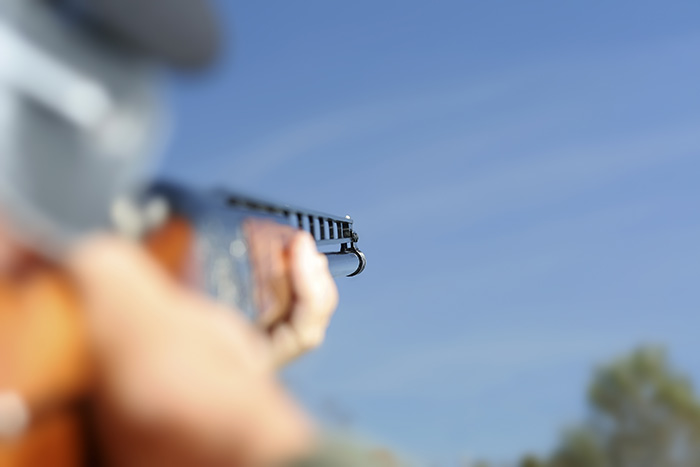Shooting Drills for Opening Day Dove & Teal

By Jessica Graham
As summer days get shorter and the first hints of autumn appear, we have two seasons approaching: Iowa’s dove and early teal seasons. These are two of the earliest and most challenging wing shooting opportunities for hunters. While doves may seem like small targets, their erratic flight patterns and incredible speed demand precision and quick reflexes.
Check Your Gun Mount
Success in the dove field isn’t just about having the right shotgun or plenty of shells; it’s about consistent, repeatable technique, and at the core of that lies the gun mount. One of the most basic, yet profoundly effective, drills to practice in preparation for dove season is the mounting drill. This isn’t about firing a single shot, but rather about building muscle memory for how your shotgun comes to your shoulder and cheek. If your gun isn’t mounted correctly and consistently, you are almost guaranteed to miss doves, no matter how good your lead or swing. A correct and consistent mount provides a solid starting point for every shot, ensuring that your eyes, the gun, and the target are all aligned from the very beginning of your movement.
The mechanics of a proper mount are straightforward but require attention to detail. Your head should remain erect, not tilted, with the stock firmly pressed against your cheekbone. Simultaneously, the butt of the shotgun should be pressed securely into the pocket of your shoulder. The goal is for the gun to become an extension of your body, pointing exactly where your eyes are looking. A critical check during this drill is to ensure the bead on your shotgun barrel is lined up directly over your dominant eye. If it’s not, you’re likely introducing an error into your aim before you even begin to swing.
Eye dominance issues can significantly impact accuracy, especially on fast-moving targets like doves. If your non-dominant eye is trying to take over, it can cause you to shoot to the side of your intended target. Some hunters find success by wearing shooting glasses and placing a piece of tape or a sticker over the lens with their non-dominant eye. This forces the dominant eye to take control. Another option is to wear an eye patch over the non-dominant eye during practice. A few dedicated sessions with either of these methods can help immensely in training your dominant eye to take primary control, leading to more accurate and consistent shooting. By perfecting your gun mount and ensuring proper eye dominance, you’ll be well on your way to a more successful and enjoyable Iowa dove season.
Shoot Some Clays
Beyond individual gun handling, shooting trap is an invaluable way to hone your skills for both dove and the upcoming waterfowl seasons. While traditional trap shooting involves targets flying away from you, you can modify your practice to mimic the diverse flight paths encountered in the field. Having the clay pigeons thrown in a pattern so they fly perpendicular to the shooter. This forces you to engage the target, smoothly mount your gun, and execute a proper swing-through. Focus on maintaining your cheek weld and shoulder pressure throughout the swing, keeping your eyes fixed on the clay.
After a few rounds, start altering the shot presentation to introduce more realism and challenge. If your clay pigeon thrower has a wobble unit, activate it to create unpredictable horizontal and vertical movements, mirroring the erratic flight of live birds. Alternatively, you can manually turn the shooting bench or adjust the position of the thrower itself to throw clays from different angles. Experiment with adjusting the thrower’s elevation and spring tension to vary the height and rise of the pigeons. Some shots might be low and fast, like a dove skimming a food plot, while others might be high and climbing. By practicing these varied presentations, you develop the versatility and adaptability crucial for reacting to the unpredictable nature of wild birds, ensuring you’re ready for whatever Iowa’s dove and waterfowl seasons throw your way.
Crucially, shooting clay pigeons helps you identify and correct common wing shooting mistakes that often go unnoticed in the heat of the moment during a hunt. Errors like “head lifting” (raising your head off the stock before the shot), “stopping your swing” (halting the gun’s movement as you pull the trigger), and an inconsistent or “bad gun mount” can all be worked out on the range. The key to diagnosing these issues is to have another person watching your technique. They can watch for these subtle yet detrimental habits. They can confirm if your head is staying down, if your swing is continuous through the target, and if your gun mount is fluid and repeatable. Addressing these fundamental flaws before the pressure hunting, will significantly boost your accuracy and confidence when dove and waterfowl seasons arrive.
Preparing for Iowa’s dove and waterfowl seasons goes far beyond simply packing your gear. It involves dedicated practice to refine fundamental wing shooting skills. By practicing mounting drills, and consistently practicing on the trap range with varied presentations, you’ll build the muscle memory and confidence needed for consistent hits.

